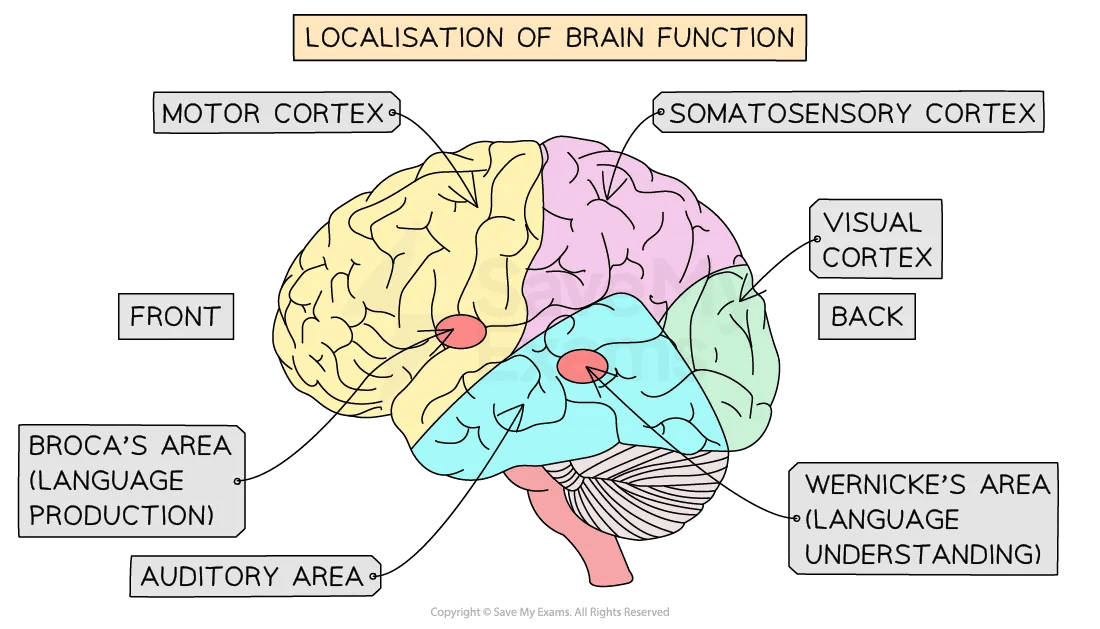Syllabus Edition
First teaching 2017
Last exams 2026
Localisation of Function in the Brain (AQA A Level Psychology): Revision Note
Exam code: 7182
Localisation of function in the brain
Localisation of brain function (LOF) is the theory that specific functions/processes are localised to/can be found in specific locations in the brain e.g.
the hippocampus has been strongly implicated in the processing of memory
the pre-frontal cortex has been linked to impulse control and executive functioning
The theory challenges and refutes previous assumptions that the brain is unimodal
LOF can be measured using brain-imaging techniques such as
MRI
fMRI
PET
Lobes of the brain
The brain is divided into two hemispheres, left and right and is covered by a thin layer known as the cerebral cortex
As each hemisphere is responsible for different functions then each lobe is responsible for specific functions located within that hemisphere
The frontal lobe and some associated areas and functions:
the motor cortex is responsible for movement
the prefrontal cortex is responsible for executive functioning
Broca's area is responsible for speech production
The temporal lobe and some associated areas and functions:
the auditory area is responsible for auditory processing e.g. hearing
Wernicke's area is responsible for language comprehension
The hippocampus is responsible for memory and spatial navigation
The parietal lobe and some associated areas and functions:
the somatosensory cortex is responsible for touch sensation e.g. heat, pain
the parietal lobe governs body orientation e.g. understanding whether an object is on the right or the left of you
the parietal lobe aids learning in the practice of complex, precise movements e.g. writing
The occipital lobe
the visual area is responsible for the processing of visual information e.g. sight
the visual area aids in understanding distance and depth perception
the visual area aids in the recognition of objects and faces
The brain also includes
the cerebellum which controls balance and coordination
the brain stem which controls involuntary responses

Evaluation of localisation of function in the brain
Strengths
There is robust evidence to support the idea of LOF e.g.
Maguire et al. (2000)
Spatial navigation is localised to the posterior hippocampus via analysis of MRI scans
The case of Phineas Gage (Harlow, 1848)
Linked personality changes to damage in the frontal lobe caused by an iron bar shooting through his eye socket and out through the top of his skull
Petersen et al.(1988)
PET scans showed that Broca's area is active when reading; Wernicke's area is active when listening
The techniques used to find supporting evidence for LOF are objective and clinical
This means that the procedure can be replicated to check for consistency
Therefore these techniques are high in reliability
Limitations
The biggest criticism of LOF was presented by Lashley (1950), who researched rats which had parts of their cortex removed
The rats' ability to navigate and memorise routes through a maze did not appear to correspond with any specific brain region
Lashley concluded that cognitive functions are shared across the cortex holistically rather than being localised to one structure/region
Lashley also suggested the law of equipotentiality as a challenge to LOF
This law states that when one part of the brain (specifically the cerebral cortex) is damaged, another part or region can take over
Research into neuroplasticity supports this
Examiner Tips and Tricks
Be very careful not to confuse localisation with lateralisation in the exam as the two theories are different (and students often make this mistake, sometimes on high-value questions).
Remember that lateralisation refers to an overall sharing of skills and functions across one larger region (e.g. the left hemisphere is more associated with language than the right).
Localisation, however, refers to the specific areas that specialise in that function. So, if lateralisation is like a department store, localisation is like the departments within it (e.g. you would go to the make-up department for eyeliner; you would find memory in the hippocampus).

Unlock more, it's free!
Did this page help you?